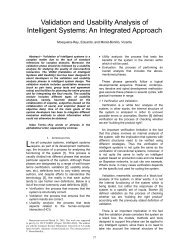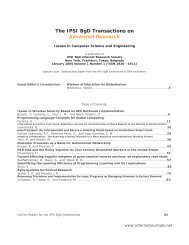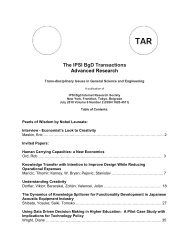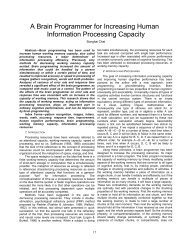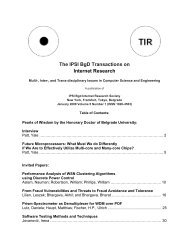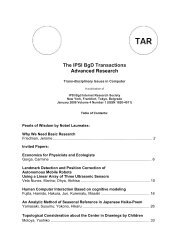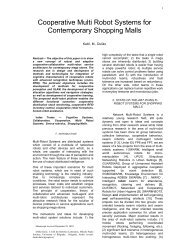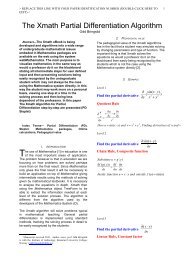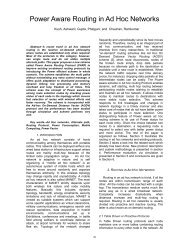The IPSI BgD Transactions on Internet Research - Welcome
The IPSI BgD Transactions on Internet Research - Welcome
The IPSI BgD Transactions on Internet Research - Welcome
Create successful ePaper yourself
Turn your PDF publications into a flip-book with our unique Google optimized e-Paper software.
your Nokia 9500 Communicator and a<br />
compatible PC.<br />
Figure 1. mBusiness IT infrastructure<br />
From a high level perspective, <strong>on</strong>e can c<strong>on</strong>sider<br />
that the business level is a variable and the IT<br />
level is relatively c<strong>on</strong>stant. Business level is<br />
variable, because it represents different types of<br />
businesses, whereas the IT infrastructure, in its<br />
general functi<strong>on</strong>ality, will remain the same for<br />
most types of mBusiness but differ in c<strong>on</strong>stituent<br />
details or nuts and bolts (range, size, structure,<br />
c<strong>on</strong>figurati<strong>on</strong>, potential, complexity etc).<br />
IT infrastructure of mBusiness includes hardware<br />
(wireless networks and mobile devices) and<br />
software (mobile business, office and enterprise<br />
applicati<strong>on</strong>s). <str<strong>on</strong>g>The</str<strong>on</strong>g> hardware or mobile devices<br />
and wireless networks will be discussed further in<br />
subsequent secti<strong>on</strong>s.<br />
4.1. Mobile devices<br />
One of the main characteristics of mobile devices<br />
used in eBusiness is the communicati<strong>on</strong> or<br />
networking facility and capacity to receive,<br />
transmit and process different types of data (text,<br />
audio, video) at high rate. In additi<strong>on</strong> to high<br />
speed data exchange, ease of handling,<br />
portability and size are important in these<br />
devices. Furthermore, these devices must be<br />
able to download essential business, office and<br />
enterprise applicati<strong>on</strong>s and have sufficient<br />
memory to run them.<br />
Currently devices used in mBusiness are<br />
wireless handheld computers, laptops, PDAs,<br />
tablet PCs, smart ph<strong>on</strong>es, Blackberry, etc. <str<strong>on</strong>g>The</str<strong>on</strong>g>se<br />
devices should be capable to run highperformance<br />
business, office and enterprise<br />
applicati<strong>on</strong>s such as multi-media, full-moti<strong>on</strong><br />
video, wireless telec<strong>on</strong>ferencing and use<br />
c<strong>on</strong>necti<strong>on</strong> over wireless networks using Wi-Fi,<br />
GPRS, Bluetooth or other advanced c<strong>on</strong>necti<strong>on</strong>s.<br />
For a better idea and distincti<strong>on</strong> between<br />
ordinary mobile devices and business quality<br />
devices and better idea about business quality<br />
mobile devices, <strong>on</strong>e could look at the features<br />
provided with Nokia 9500 that have a full set of<br />
critical business tools, full keyboard, with a large<br />
memory capacity and versatile network<br />
c<strong>on</strong>necti<strong>on</strong>s (Nokia, 2005):<br />
Browse the <strong>Internet</strong> in rich full color, <strong>on</strong> a wide,<br />
easy-to-read screen. Work with office documents<br />
- not just email and memos, but presentati<strong>on</strong>s<br />
and databases too. Get them from your<br />
corporate network via Wireless LAN or EDGE for<br />
fast mobile access. Keep your Pers<strong>on</strong>al<br />
Informati<strong>on</strong> Management data in sync and up-todate<br />
calendar and c<strong>on</strong>tacts - with PC Suite and<br />
SyncML, you can easily exchange data between<br />
4.2. Wireless Networks<br />
Although not in mass applicati<strong>on</strong> yet, but in the<br />
future mBusiness will be operating <strong>on</strong> third<br />
generati<strong>on</strong> wireless networks, 3G, that provide<br />
high speed download and upload rate. <str<strong>on</strong>g>The</str<strong>on</strong>g><br />
speed of transmissi<strong>on</strong> in these networks using<br />
mobile devices is at the level of DSL<br />
c<strong>on</strong>necti<strong>on</strong>s. Because data costs <strong>on</strong> 3G<br />
networks are lower than <strong>on</strong> traditi<strong>on</strong>al networks<br />
(Solheim, 2005) more and more enterprises will<br />
shift into using 3G networks as main<br />
infrastructure.<br />
Currently, mBusinesses are based <strong>on</strong> different<br />
types of networking technology:<br />
Pers<strong>on</strong>al area network using Bluetooth<br />
technology that enables short-range device-todevice<br />
wireless c<strong>on</strong>necti<strong>on</strong>s within a small space<br />
(office, a desktop, a pers<strong>on</strong>al space).<br />
Wireless local area networks using Wi-Fi<br />
technology, based <strong>on</strong> IEEE 802.20, 802.11<br />
standards, which supports a wireless c<strong>on</strong>necti<strong>on</strong><br />
to a network from inside a home or from a<br />
hotspot in a building, campus, or airport.<br />
Wireless metropolitan area networks using<br />
WiMax, based <strong>on</strong> IEEE 802.16 standard, will<br />
enable any remote worker to make a wireless<br />
c<strong>on</strong>necti<strong>on</strong> anywhere in a range up to 50<br />
kilometers.<br />
Wireless wide area networks or 3G networks<br />
provide the highest available bandwidth for<br />
mobile devices. Although, theoretical rate of<br />
transmissi<strong>on</strong> is 2Mb, but for practical purposes<br />
the transmissi<strong>on</strong> speed is like DSL which enables<br />
users to download text, audio, video, web<br />
c<strong>on</strong>tents, and send or receive e-mail while in<br />
moti<strong>on</strong>.<br />
4G technologies promise to integrate different<br />
modes of wireless communicati<strong>on</strong>s – from indoor<br />
networks such as wireless LANs and Bluetooth,<br />
to cellular signals, to radio and TV broadcasting,<br />
to satellite communicati<strong>on</strong>s.<br />
5. ISSUES OF M-BUSINESS<br />
In the previous secti<strong>on</strong>s we discussed<br />
advantages and benefits of mBusiness, however,<br />
enterprise managers and business owners ought<br />
to be aware of issues and challenges before<br />
undertaking the transformati<strong>on</strong> initiative.<br />
It would not be less than an illusi<strong>on</strong>, if c<strong>on</strong>sider<br />
transiti<strong>on</strong> from traditi<strong>on</strong>al or eBusiness to<br />
mBusiness as just shifting from wired<br />
envir<strong>on</strong>ment to wireless communicati<strong>on</strong> and<br />
networking. <str<strong>on</strong>g>The</str<strong>on</strong>g> transformati<strong>on</strong> into mobile<br />
business is not just about moving from wired<br />
envir<strong>on</strong>ment to wireless, from desktops to<br />
handheld computers or from office to field. Also<br />
the challenge of adapting mBusiness is not <strong>on</strong>ly<br />
about acquisiti<strong>on</strong> and implementati<strong>on</strong> of best<br />
wireless technology or awareness of emerging<br />
mobile technology, but it is rather a multi-<br />
50



